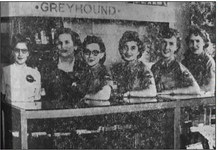PAGING THROUGH H


ABBOTSFORD T RIBUNE PUBLISHED IN ABBOTSFORD THURSDAY, MAY 31, 1951
Coffee Shop an attractive and restful eating place
The Coffee Shop and bus depot, operated by Mr. and Mrs. Ernest Sjolin, has recently been redecorated in an attractive color scheme of chartreuse and red. The black wall is papered in a cool green colonial paper with a strolling couple dressed in chartreuse and red.
The same colors are repeated in the hand blocked linen drapes at the front windows where Venetian blinds filter the light in the rest of the window.
The ceiling and side walls are chartreuse with a brown leatherette wainscot. Green and white table clothes and green white cream tile floor blend with the color scheme.
A new ticket and office counter and candy counter in blonde finish were installed.
The kitchen is also finished in chartreuse walls with red cupboards.
The eating counter, lined with red linoleum, and the steam in the kitchen, were designed by Mrs. Sjolin, as were the attractive new uniforms worn by the waitresses. They are of gray to conform with the gray uniforms worn by the Greyhound bus drivers, with the Greyhound emblem on the left sleeve. With the uniforms, the girls wear pert little gray caps and aprons with three blue stripes at the bottom.
The Coffee Shop is open 24 hours of the day, and starting June 1, will serve fish and French fries in baskets, specializing in white fish on Friday, Saturday and Sunday.
The personnel at the Coffee Shop includes Mr. and Mrs. Sjolin, the five waitresses pictured above and the kitchen help.
THE TRIBUNE-P HONOGRAPH PUBLISHED IN ABBOTSFORD WEDNESDAY, MAY 27, 1981
Abbotsford board gets taste of upcoming budget problems
One Abbotsford alderman said it was “the best news we’ve heard all night.” And for a city that needs more water, it was indeed good news that Harvey Stricker of Lane-Northwest water gave to the council Monday.
Lane-Northwest has been exploring the area for suitable new well locations, and Stricker’s message was that there are several sites that should provide Abbotsford with all the water it needs to expand in the years to come. Stricker mentioned four priority site as areas that would pay off if they were turned into operating wells. Three are on the Watson farm, which the city now owns, and a fourth in nearby on the railroad right-of-way.
Two wells were suggested as the top prospects are estimated to be capable of generating 125-180 gallons a minute and 60-100 gallons a minute, respectively. The capacity of a third well site was put at 40-60 gallons a minute, and a fourth, described as a “backup” by Stricker, would provide between 75 and 100 gallons a minute, he said.
The city now uses between 100,000 and 200,000 gallons a day, or around 100 gallons per minute, so the wells drilled at the test sites should, as Stricker said, “serve the city well for many years.”
The consultant said the water was of “excellent” quality, with very little iron and nitrate concentration, ranging from .08 or two parts million (ppm). He noted other wells south of there were getting up to 25 to 30 ppm of nitrates. Stricker recommended making them immediately with tall steel pole so there is no mistake about their location.
